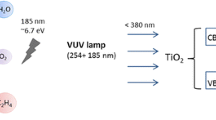Abstract
Using vinyl-silsesquioxane modified with various amounts of tetraethoxysilane (TEOS) and titanium tetrabutoxide (TTB), two kinds of hybrid films, film-vinyl-silsesquioxane-TEOS (f-VSTE) and film-vinyl-silsesquioxane-TTB (f-VSTT), were prepared. The average transparency (AT) of the modified films was measured in the ranges of the visible light region (400–750 nm) and in the near-infrared region (750–2500 nm). The AT values in these ranges are about 88% to 94%, indicating that these high-AT films can provide crops with growth energy and improvement of the photosynthetic process efficiency. The TEOS additions result in a hybrid structure (containing SiO2); an adequate addition can cause an increase in the AT radiation from sunlight. On the other hand, the TTB additions result in a hybrid structure (containing TiO2) that causes a decrease in the AT. These results were validated using molecular dynamic simulation and were calculated (with Materials Stutio software) using the density of states and the energy-band structure of the vinyl-SSO, SiO2, and TiO2 building blocks.
Similar content being viewed by others
References
T. You, S.M. Barnett Effect of light quality on production of extracellular polysaccharides and growth rate of Porphyridium cruentum. Biochem. Eng. J. 19, 251 (2004)
J.U. Grobbelaar, L. Nedbal, V. Tichy Influence of high frequency light/dark fluctuations on photosynthetic characteristics of microalgae photoacclimated to different light intensities and implications for mass algal cultivation. J. Appl. Phycol. 8, (4–5) 335 (1996)
J.W. Bartok Assimilation lighting for greenhouses. USDA Forest Service Rocky Mnt. Res. Station Proc. 28, 74 (2003)
W.J. Roberts Let the sunshine in. Resource Eng. Technol. Sustainable World 8, (7) 7 (2001)
P. Chen, T. Liu, D. Wang, Y. Liu, L-J Hu Silsesquioxane materials as sun protection factor ingredients and as films for greenhouse covers. Mater. Sci. Forum 610–613, 104 (2009)
B. Arkles Commercial applications of sol-gel-derived hybrid materials. MRS Bull. 26, 402 (2001)
D. Wang, X-D Chen, X-W Zhang, Y. Liu, L-J Hu Enhancement corrosion resistance of (3-methacryloxypropyl)silsesquioxane hybrid films and its validation by gas-molecule diffusion coefficients using MD simulation. J. Sol-Gel. Sci. Technol. (Paris) 49, (3) 293 (2009)
D.A. Loy, J.P. Carpenter, T.M. Alam, R. Shaltout, P.K. Dorhout, J. Greaves, J.H. Small, K.J. Shea Cyclization phenomena in the sol-gel polymerization of α, ω-bis(triethoxysilyl)alkanes and incorporation of the cyclic structures into network silsesquioxane polymers. J. Am. Chem. Soc. 121, 5413 (1999)
D.A. Loy Hybrid organic-inorganic materials. MRS Bull. 26, (5) 364 (2001)
C.L. Soles, E.K. Lin, W-L Wu, C-X Zhang, R.M. Laine Structural evolution of silsesquioxane-based organic/inorganic nanocomposite networks (Mater. Res. Soc. Symp. Proc 628, Warrendale, PA 2000) CC4.2.1
Maiez-S. Tribut, J.P. Pascault, E.R. Soule, J. Borrajo, R.J.J. Williams Nanostructured epoxies based on the self-assembly of block copolymers: A new miscible block that can be tailored to different epoxy formulations. Macromolecules 40, 1268 (2007)
X-W Zhang, L-J Hu, D-Z Sun, W. Zhao Study of three-dimensional configurations of organic/ inorganic hybrid nanostructural blocks: A quantum chemical investigation for cage structure of (γ-glycidoxypropyl)silsesquioxanes. J. Mol. Struct. 872, 197 (2008)
A. Matsuda, T. Sasaki Photocatalytic micropatterning of transparent ethylsisesquioxane-titania hybrid films. Chem. Mater. 14, 2693 (2002)
H.J. Monkhorst, J.D. Pack Special points for Brillouin-zone integrations. Phys. Rev. B 13, 5188 (1976)
G.U. Oertzen, A.R. Gerson The effects of O deficiency on the electronic structure of rutile TiO2. J. Phys. Chem. Solids 68, (3) 324 (2007)
J. Sun, H-T Wang, J-L He, Y-J Tian Ab initio investigations of optical properties of the high-pressure phases of ZnO. Phys. Rev. B 71, (12) 125 (2005)
X-W Zhang, L-J Hu, Y-D Huang, D-Z Sun Three-dimensional configurations of organic/inorganic hybrid nanostructural blocks (I) A quantum mechanical investigation for ladder-like structure of vinylsisesquioxane. Sci. China, Ser. B Chem. 47, 388 (2004)
R.T. Cygan, J.J. Liang, A.G. Kalinichev Molecular models of hydroxides, oxyhydroxide, and clay phases and the development of a general force field. J. Phys. Chem. B 108, 1255 (2004)
C.R. Bradley, A.P. Cracknell The Mathematical Theory of Symmetry in Solids (Clarendon Press, Oxford 1972)
A. Bhardwaj, S.K. Muthu A model with a singular electronic density of states and some properties of high-temperature superconductors. Phys. Status Solidi B 218, (2) 503 (2000)
M.C. Warren, G.J. Ackland, B.B. Karki, S.J. Clark Phase transitions in silicate perovskites from first principles. Mineral. Mag. 62, 585 (1998)
Hernandez-J. Paredes, Glossman-D. Mitnik, Esparza-H.E. Ponce, Alvarez-M.E. Ramos, Duarte-A. Moller Band structure, optical properties and infrared spectrum of glycine-sodium nitrate crystal. J. Mol. Struct. 875, (1–3) 295 (2008)
X-D Chen, D. Wang, X-D Li, Y. Liu, L-J Hu POSS/TiO2 nanohybrids as sun protection factors for skin changes caused by ultraviolet A radiation. Mater. Sci. Forum 610–613, 1039 (2009)
L-J Hu, X-W Zhang, Y-D Huang Nano-scratch profiles of hybrid films based on (3-glycidoxypropyl) trimethoxysilane and modified with tetraethoxysilanes. Plast. Rubber Compos. 33, (9) 457 (2004)
L-J Hu, D. Wang, Z-S Lu, Y-W Song, C-M Song Influence of titanium tetrabutoxide on nanoindentation and nanoscratch profiles of silsesquioxane films. Macromol. Symp. 267, 85 (2008)
Author information
Authors and Affiliations
Corresponding author
Rights and permissions
About this article
Cite this article
Chen, XD., Wang, D., Lin, DR. et al. Transparency of modified vinyl-silsesquioxane films and its validation by computing energy-band structure. Journal of Materials Research 25, 76–81 (2010). https://doi.org/10.1557/JMR.2010.0022
Received:
Accepted:
Published:
Issue Date:
DOI: https://doi.org/10.1557/JMR.2010.0022



